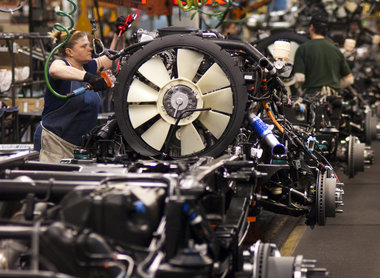Michigan’s economic comeback promising, but incomplete
The original version of this story misstated Michigan’s gross domestic product in 2005 and 2013. The numbers are $433 billion and $408 billion, respectively. The original text incorrectly stated the numbers in trillions.
Economic data can be a glass half-full, half-empty proposition.
Half-full? Most regions in Michigan posted solid GDP gains in 2013 and statewide growth of 2 percent led a five-state Midwest region. The recovery continues.
Half-empty? We're not all the way back.
Michigan gross domestic product has yet to reach its peak output of $433 billion in 2005. It measured $408 billion in 2013, with both figures calculated in 2009 dollars. Moreover, not one of the 14 Michigan regions tracked by the U.S. Bureau of Economic Analysis has reached the output of its peak year.
Former state Treasurer Doug Roberts is not surprised Michigan remains below its peak output of a decade ago. But he's a glass-half-full guy.
“It may take a couple more years, but we are going to get there. We have fundamentally turned around. Are we all the way back? No. But we are going in the right direction.”
The Grand Rapids region is closest to a full comeback, standing just .4 percent below its peak year of 2005. The Jackson region is next, at .7 percent below its peak in 2005 and then the Muskegon region, .9 percent below its peak the same year.
At the other end, the Flint region remained 16.9 percent below its peak in 2003 and Midland 13.4 percent below its peak in 2004. The Saginaw region was 9.1 percent below its peak 2003 and the Detroit region 8 percent below its peak in 2005.
Monroe, which posted the biggest GDP percentage gain in 2013, at 5.5 percent, remains 6.8 percent below its peak in 2003.
As Flint goes
Flint's pain is a microcosm of why Michigan's recovery lags the rest of the country ‒ the implosion of the auto industry. In 1975, the sprawling Flint East auto parts plant was home to 14,000 workers. It ceased operations in 2013, leaving the remaining 287 workers to find other work.
General Motors once employed 80,000 in the Flint area - now fewer than 8,000. Statewide, manufacturing employed 515,000 in 2013 – still 200,000 below 2003.
Flint manufacturing output is 44 percent of its peak year of 2003 and just over half of what it was in 2007. It fell another 4.5 percent in 2013.
Roberts, the former state treasurer, said he believes manufacturing will continue to be critical to Michigan's prosperity in the years ahead. It's still 19 percent of the state economy, after falling to 14.6 percent in 2009. But, he added, tourism, trade and the health-care industry – as it cares for an aging population – will drive the state’s future economic growth.
Business Watch
Covering the intersection of business and policy, and informing Michigan employers and workers on the long road back from coronavirus.
- About Business Watch
- Subscribe
- Share tips and questions with Bridge Business Editor Paula Gardner
Thanks to our Business Watch sponsors.
Support Bridge's nonprofit civic journalism. Donate today.
See what new members are saying about why they donated to Bridge Michigan:
- “In order for this information to be accurate and unbiased it must be underwritten by its readers, not by special interests.” - Larry S.
- “Not many other media sources report on the topics Bridge does.” - Susan B.
- “Your journalism is outstanding and rare these days.” - Mark S.
If you want to ensure the future of nonpartisan, nonprofit Michigan journalism, please become a member today. You, too, will be asked why you donated and maybe we'll feature your quote next time!


 A section of Chevrolet Silverado is put together on an assembly line at General Motors' Flint Assembly in this Flint Journal file photo. (Used with permission)
A section of Chevrolet Silverado is put together on an assembly line at General Motors' Flint Assembly in this Flint Journal file photo. (Used with permission)